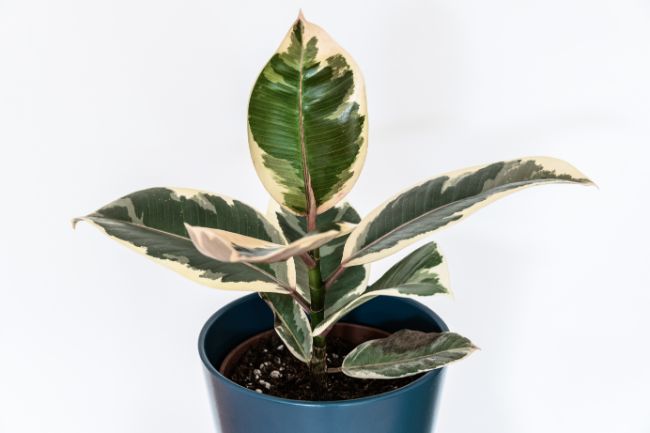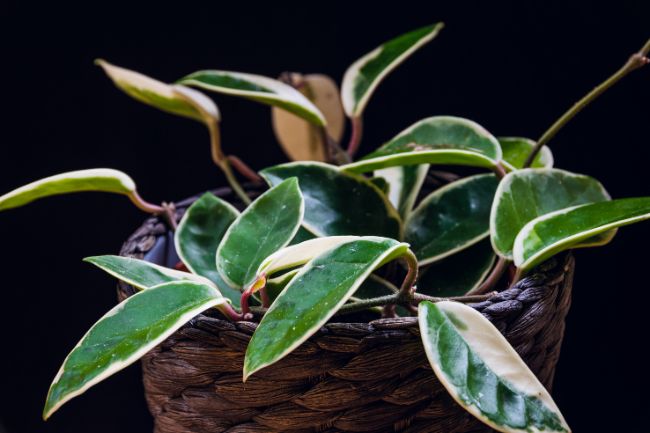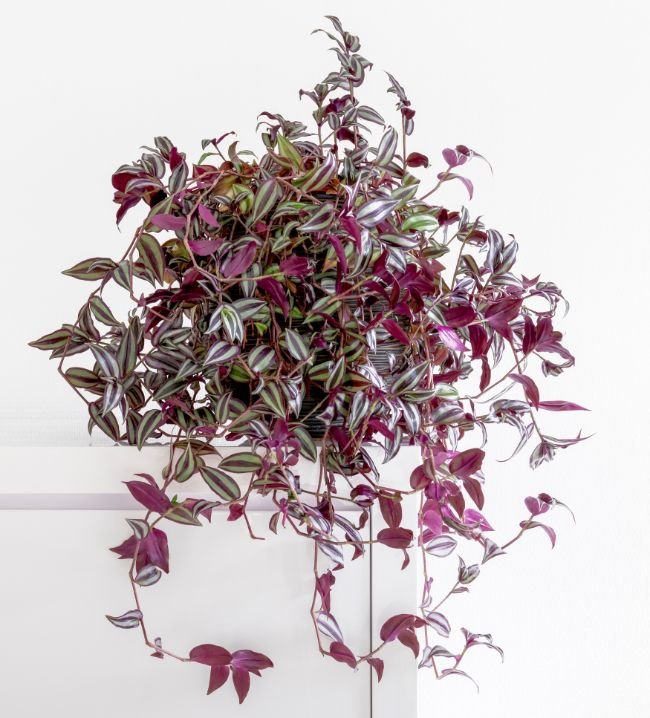The houseplant community across the world is in love with variegated plants – and why not, considering these stunning beauties can add character to any space and enhance its aesthetic appeal. This article covers some of my favorite variegated houseplants that I know you’ll be unable to resist.
Have a look at this list of 16 beautiful variegated houseplants and take your pick. And don’t blame me if you’re unable to pick just one for they’re all super gorgeous!
Philodendron Birkin

The Philodendron Birkin is a unique and rare houseplant that belongs to the Araceae family, and features attractive rounded leaves with dramatic pin-stripe lines across their face.
It looks so attractive that it seems like the angels themselves painted intricate patterns on its foliage! This designer plant is a slow-growing one and stays compact in size. And since this a tropical plant, it thrives in bright, indirect light, warm, humid conditions.
But don’t worry, you don’t need to transform your home into a greenhouse just yet!
You can just place the plant container on a pebble tray filled with water to get the humidity part sorted. As for temperature, make sure you don’t let it fall under 55°F (13°C) and keep this beauty in a place where it gets lots of indirect sunlight.
Also, the Philodendron Birkin loves moist soil, but avoid overwatering as that might lead to wet feet and cause its attractive foliage to wilt and die.
Ficus Elastica ‘Tineke’ (Rubber Plant)

This houseplant is a cultivated variety of the popular Rubber Tree aka Ficus Elastica. The ‘Tineke’ has thick, leathery leaves just like a rubber tree, but they are not deep green in color. Rather they are beautifully variegated displaying green, white and pinkish hues, making it an absolute treat to the eyes.
Have some corner of your home that could do with a little perking up? Just adorn it with this spectacular houseplant and marvel at the wonderful transformation!
Because the Ficus Elastica ‘Tineke’ is indigenous to tropical rainforests, it requires generous doses of humidity, warmth, and indirect light. When kept indoors, make sure to keep this beauty far from air conditioners/heaters, or cold drafts from windows or doors.
Rubber plants are fairly forgiving when it comes to their care requirements, You can read my Rubber Plant care guide for more info.
Stromanthe Sanguinea ‘Triostar’

The Triostar plant is the perfect way to add a bit of drama and exotic tropical vibes to any space. This plant’s fabulous pointed foliage displays attractive pastel stripes in light green, cream and pink colors on the top. The underside of the leaves is even more striking in bright pink or a maroon-ish shade.
And as if all this gorgeousness was not enough, this beauty from the prayer plant family naturally folds up its leaves at night, proudly showing off their vibrant undersides!
If you love your ‘Triostar’ deeply enough (which, by the way, is impossible not to) it can grow up to 4-5 feet high and about 2-3 feet across at maturity. As for caring for this wonderful houseplant, you need to give it the right amount of humidity, sunlight (no direct sun though) and water to see it thrive.
If you’d like to learn more, I’ve written an article all about Stromanthe Triostar, covering how to keep these stunningly beautiful variegated houseplants healthy.
Hoya Carnosa ‘Albomarginata’

Thick and shiny waxy leaves tinted with pink and white, unbelievably perfect clusters of pale pink flowers, long flowing vines – what’s not to love about the gorgeousness that is the Hoya Carnosa ‘Albomarginata’!
This super attractive houseplant has the honor of being the ‘dream plant’ of many plant lovers owing to its delightful appearance and easy-going nature.
Since this plant is a semi-succulent, it is pretty forgiving if you forget to water it from time to time. Just refrain from overwatering and give it lots of bright indirect light, and it is sure to flourish.
This houseplant’s feeding requirements are also not much – you need to fertilize it once a month from April to October. As for toxicity, Hoya is generally considered non-toxic for pets; but its leaves, if consumed in large quantities, can cause your pup or kitten to throw up.
Tradescantia Zebrina

The Tradescantia Zebrina or the Wandering Jew plant, as it is more commonly known, is a fast-growing, beautifully-patterned perennial plant native to Southern Mexico and Guatemala.
The top of its variegated foliage displays stunning purple and green longitudinal stripes while the underneath is deep magenta-hued. On close inspection, you’ll notice fine hair along the margin of each leaf.
Like Pothos, these variegated houseplants are survivors, thriving in the most inhospitable conditions by displaying extraordinary resilience. They’re not very fussy about placement and can survive with infrequent watering with ease. If you’d like to learn more about this awesome houseplant, read my Tradescantia zebrina care guide.
Philodendron ‘Florida Ghost’
Do you know why this plant is called the ‘Florida Ghost’? It’s because of the almost ‘ghostly’ white color of its new leaves! As they mature, the leaves start turning an attractive lime green before turning deep green in a matter of one to two weeks.
This means that at any time, the Philodendron ‘Florida Ghost’ houseplant will have mixed green foliage that lends it its unusual appearance.
When it comes to caring for this rare and unique houseplant, you need to give it an environment that is similar to its natural habitat (rainforest). This means you should ensure lots of humidity along with ample bright, indirect light and quick-draining soil mix. And since this pant is a climber, attaching some kind of plant support to it would be a great idea.
Please note that if you have young kids or pets at home, you might want to reconsider going for this plant as it is toxic in nature.
Monstera Deliciosa ‘Albovariegata’

Capturing the hearts of thousands of plant enthusiasts in every corner of the world, the heavily variegated Monstera Deliciosa ‘Albovariegata’ is a rare beauty.
The iconic leaves of the Monstera with all those holes and ridges are very much present in this spectacular variety – but they are rendered even more striking with pure white and green variegation. No wonder you can often spot this stunning plant in home décor magazines and scores of Instagram posts!
Caring for this plant is very much similar to caring for the good old Monstera. It requires warm and humid environment, gentle sunlight and moist, well-draining soil.
One thing important to note here is that since the white part of the leaves of this variegated Monstera cannot absorb light, it needs lots of bright, indirect light to flourish properly. So it is best to place it near a window or out in the patio to make it truly happy.
The only drawbacks to this gorgeous plant are price and availability. Expect to pay a hefty sum, even for just a cutting, and tracking one down can also be a challenge.
Epipremnum Aureum (Pothos)

If variegated houseplants make your heart skip a beat, but you’re reluctant to go for them as you usually end up killing most of your green babies, the Epipremnum Aureum or the Golden Pothos is sure to give you hope.
This is because not only is this houseplant crazy gorgeous with its trailing stems cascading from hanging containers, it will survive in almost any condition. In fact, it wouldn’t be an exaggeration to say that this plant actually thrives on neglect!
Also known as the Devil’s Ivy due to its ability to thrive in adverse circumstances, this plant boasts of pretty heart-shaped leaves variegated with pale yellow or white color. It is considered an excellent plant for office spaces as it does wonderfully under fluorescent lighting.
And although it will thrive in dark or low-light corners, please note that its leaves may lose their colorfulness and turn completely green – something you wouldn’t want to happen if you love variegated plants.
Peperomia Obtusifolia Variegata

The Peperomia Obtusifolia Variegata is a variegated succulent-like variety of the Baby Rubber Plant that is native to South America’s rainforests. Its glossy, fleshy leaves in multiple shades of creamy white, dark green and pale olive green grow on thin, non-woody stems, and lend it a charisma that is hard to miss. This is a pretty compact plant that can grow up to one-foot tall and is usually bushy in appearance.
Just like most other Peperomias, this one has fairly simple care requirements. Give it proper humidity and light to keep it happy and water it only when you notice the upper few inches of the soil have dried out. Remember that this plant does not require much water as its leaves are capable of storing water.
Calathea Orbifolia

This one is native to Bolivia and is one of the largest Calatheas to be found. With round foliage displaying striking dark green and silver stripes, this gem of a houseplant can effortlessly give a designer touch to any space.
It owes its elegance to its large leaves that grow pretty wide as the plant inches towards maturity. It’s so satisfying to see new leaves slowly unfurl as they emerge tightly curled. Hold your breath as you wait to see if all your love and attention has produced another stunning leaf.
Calatheas can be tricky to keep in top condition unless you provide consistent and suitable conditions. It is happiest when given lots of humidity, moist soil and dappled light (just like it gets under the canopy of trees in its natural habitat).
If you are up for the challenge, these stunning variegated houseplants will bring you years of pleasure. Check out my article about Calathea orbifolia care to learn more.
Scindapsus Pictus (Satin Pothos)

The Scindapsus Pictus or the Satin Pothos is a close relative of the Golden Pothos and is just as forgiving. It has the same glossy, heart-shaped leaves, but with silver-ish speckles which make it look absolutely stunning.
As an indoor plant, the satin pothos prefers hanging rather than climbing, so you can place them in hanging containers where its vines can beautifully dangle down. It can also be a great addition to your terrarium as it loves humid conditions.
Although these tolerant variegated houseplants will not complain at all if you are a forgetful plant parent when it comes to watering, it does not appreciate soggy soil. So make sure to water it only when the top 1-2 inches of the soil completely dry out.
As for lighting, bright ambient light brings out the best leaf color and variegation, but a satin pothos plant can also tolerate low-light conditions nicely.
Dracaena Fragrans Lemon Lime

This houseplant is extremely popular among enthusiasts who are fans of variegated houseplants. It features long, arching leaves with lemon green, dark green, and white stripes. All the leaves spread out beautifully from a central stem that gives it an eye-catching look. If you want to add a refreshing touch to your office or living space, this plant is all you need!
The Dracaena Fragrans Lemon Lime is a fairly easy care plant that does well with moderate watering and indirect sunlight. It prefers warm surroundings but can tolerate temperatures as low as 50°F (10°C) for some time.
Please note that browning, drying and falling off of lower leaves is a common phenomenon in Dracaena plants as it grows. So unless the leaf fall is persistent, this should not be a cause for worry. Also, it can be toxic for pets when ingested, so you have to be careful about that.
Chlorophytum Comosum (Spider Plant)

The spider plant, or the Chlorophytum comosum as it is scientifically called, is one of the most popular houseplants across the world. It is a decorative little plant that looks highly appealing as its long ribbon-like variegated leaves with green and pale white stripes dangle over its container’s edges.
In the summer season, you can even spot tiny white star-shaped flowers peeking out of the dense foliage, which kind of doubles up its charm.
Now this one is also an easily adapting plant which makes it perfect for the indoor environment. It can survive dry spells, low light and even manage low temperatures.
But be careful because, after continuous neglect, it will start looking pretty shabby and unattractive with browning leaves, particularly the tips. With proper attention and care, this plant will continue to steal hearts and uplift the ambiance of your home.
Calathea Zebrina

If you spot a stunning tropical plant with large ovate leaves that are light green in color but sport dark green stripes just like a zebra, chances are you’re looking at the Calathea Zebrina or the Zebra plant.
Like all Calathea, it needs love and attention to stay looking it’s best. It demands a warm and moist environment with tons of humidity. This isn’t a plant I’d recommend to beginners, but if you are up to the challenge, it is well worth the effort.
Aglaonema ‘Silver Queen’

This evergreen perennial is not called the ‘Silver Queen’ for nothing – its enigmatic silvery-green foliage looks so stunning that this plant could be a perfect gift for royalty.
The lance-shaped variegated leaves sprout from short stems and grow in an upright fashion, lending it its unique appearance. Whether it is your office, living room, patio or sheltered garden, this beauty will look absolutely wonderful in each setting.
Now if you want to keep your Silver Queen happy, place it in bright, indirect light, but avoid direct sunlight. And although this plant loves moist soil, try not to go overboard with watering as that will cause root rot.
Remember moderation is the key when it comes to watering your silver queen. Further, this lovely plant does not have any specific humidity requirements, but it definitely does not appreciate being exposed to cold drafts.
Sansevieria Trifasciata ‘Golden Hahnii’ (Snake Plant)

This plant might be small in stature, but don’t let that fool you for a second! When it comes to toughness, the Golden Hahnii can outshine most others on this list – and it seriously impresses in the looks department too. This variegated and compact version of the Bird’s Nest Snake Plant grows in tight rosettes of glossy green leaves with attractive yellowish margins and can get no more than 6 inches tall.
This is a hardy and robust plant that is super easy to grow and care for. It is pretty drought tolerant, but won’t appreciate overwatering or poorly draining soil as that will cause its roots to rot. It grows well in moderate to bright, indirect light and can tolerate temperatures as low as 50°F (10°C) for a short duration.


